NISSAN ALTIMA 2002 L31 / 3.G Owner's Manual
Manufacturer: NISSAN, Model Year: 2002, Model line: ALTIMA, Model: NISSAN ALTIMA 2002 L31 / 3.GPages: 249, PDF Size: 2.02 MB
Page 21 of 249

Supplemental front air bag system
The driver supplemental air bag is located in
the center of the steering wheel; the front
passenger supplemental air bag is mounted in
the dashboard above the glove box. Thesesystems are designed to meet optional certi-
fication requirements under U.S. regulations.
They are also permitted in Canada. The op-
tional certification allows front air bags to be
designed to inflate somewhat less forcefully
than previously.However, all of the informa-tion, cautions and warnings in this manual
still apply and must be followed.The front
air bags are designed to inflate in higher
severity frontal collisions, although they may
inflate if the forces in another type of collision
are similar to those of a higher severity frontal
impact. They may not inflate in certain frontal
collisions. Vehicle damage (or lack of it) is not
always an indication of proper supplemental
air bag operation.
The supplemental air bag system has dual
stage inflators for both the driver and pas-
senger air bags. The system monitors infor-
mation from the crash zone sensor, the
diagnosis sensor unit and seat belt buckle
sensors that detect if the seat belts are
fastened. Inflator operation is based on the
severity of a collision and whether the seat
belts are being used.
When the supplemental front air bag in-
flates, a fairly loud noise may be heard,
followed by release of smoke. This smoke is
not harmful and does not indicate a fire.
Care should be taken not to inhale it, as it
may cause irritation and choking. Those
with a history of a breathing condition
should get fresh air promptly.
Supplemental front air bags, along with the
LRS0104
1-14Seats, restraints and supplemental air bag systems
ZX
Page 22 of 249
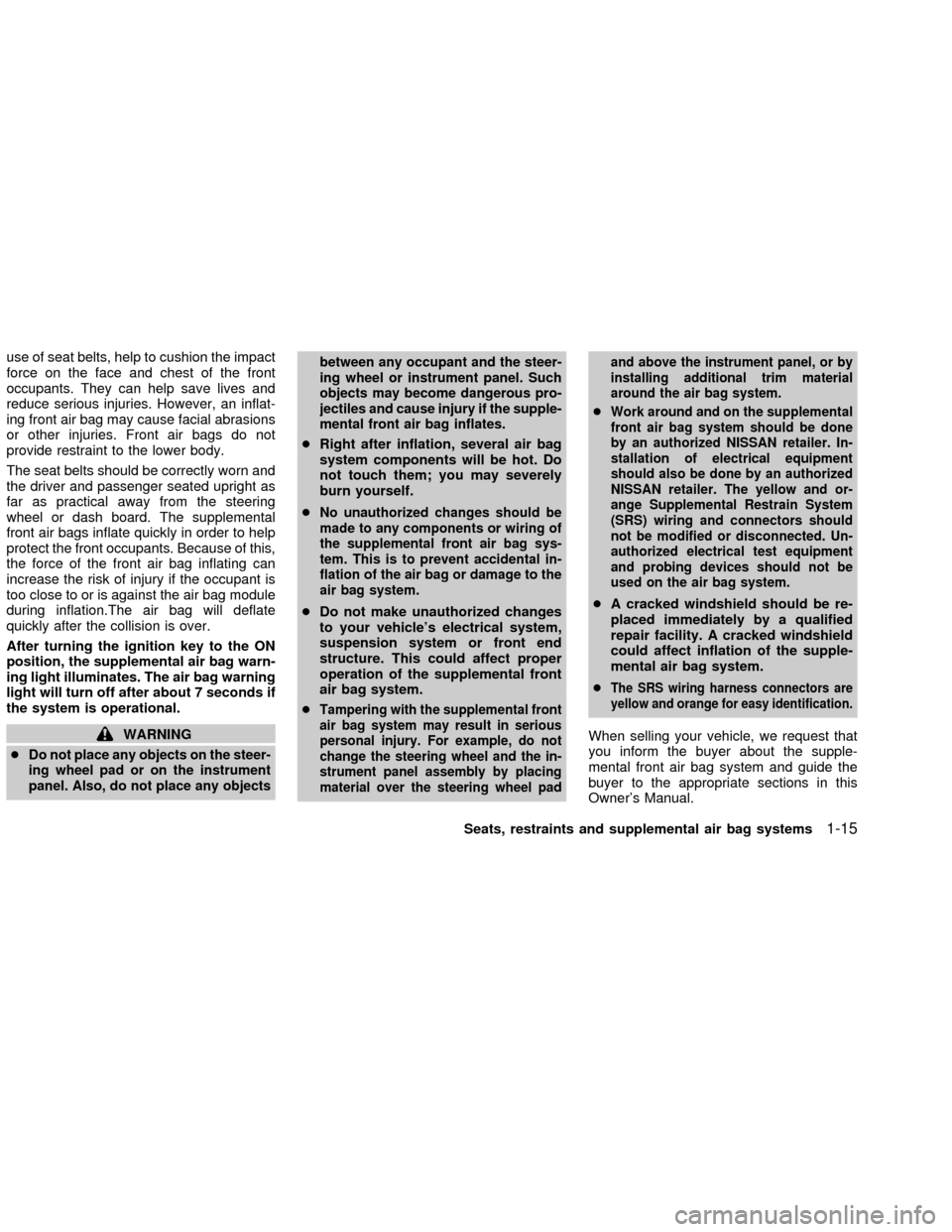
use of seat belts, help to cushion the impact
force on the face and chest of the front
occupants. They can help save lives and
reduce serious injuries. However, an inflat-
ing front air bag may cause facial abrasions
or other injuries. Front air bags do not
provide restraint to the lower body.
The seat belts should be correctly worn and
the driver and passenger seated upright as
far as practical away from the steering
wheel or dash board. The supplemental
front air bags inflate quickly in order to help
protect the front occupants. Because of this,
the force of the front air bag inflating can
increase the risk of injury if the occupant is
too close to or is against the air bag module
during inflation.The air bag will deflate
quickly after the collision is over.
After turning the ignition key to the ON
position, the supplemental air bag warn-
ing light illuminates. The air bag warning
light will turn off after about 7 seconds if
the system is operational.
WARNING
c
Do not place any objects on the steer-
ing wheel pad or on the instrument
panel. Also, do not place any objectsbetween any occupant and the steer-
ing wheel or instrument panel. Such
objects may become dangerous pro-
jectiles and cause injury if the supple-
mental front air bag inflates.
cRight after inflation, several air bag
system components will be hot. Do
not touch them; you may severely
burn yourself.
c
No unauthorized changes should be
made to any components or wiring of
the supplemental front air bag sys-
tem. This is to prevent accidental in-
flation of the air bag or damage to the
air bag system.
cDo not make unauthorized changes
to your vehicle's electrical system,
suspension system or front end
structure. This could affect proper
operation of the supplemental front
air bag system.
c
Tampering with the supplemental front
air bag system may result in serious
personal injury. For example, do not
change the steering wheel and the in-
strument panel assembly by placing
material over the steering wheel padand above the instrument panel, or by
installing additional trim material
around the air bag system.
cWork around and on the supplemental
front air bag system should be done
by an authorized NISSAN retailer. In-
stallation of electrical equipment
should also be done by an authorized
NISSAN retailer. The yellow and or-
ange Supplemental Restrain System
(SRS) wiring and connectors should
not be modified or disconnected. Un-
authorized electrical test equipment
and probing devices should not be
used on the air bag system.
cA cracked windshield should be re-
placed immediately by a qualified
repair facility. A cracked windshield
could affect inflation of the supple-
mental air bag system.
c
The SRS wiring harness connectors are
yellow and orange for easy identification.
When selling your vehicle, we request that
you inform the buyer about the supple-
mental front air bag system and guide the
buyer to the appropriate sections in this
Owner's Manual.
Seats, restraints and supplemental air bag systems
1-15
ZX
Page 23 of 249
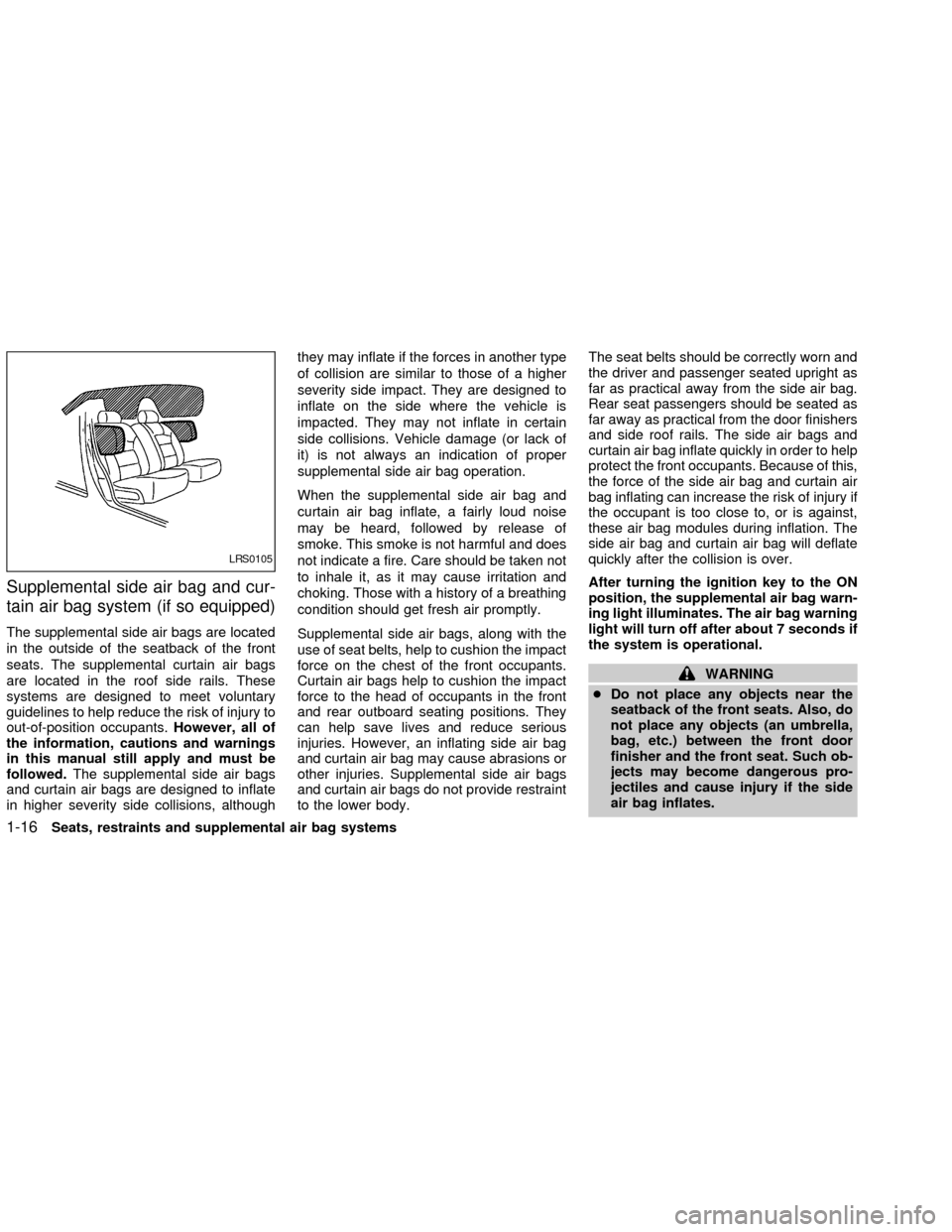
Supplemental side air bag and cur-
tain air bag system (if so equipped)
The supplemental side air bags are located
in the outside of the seatback of the front
seats. The supplemental curtain air bags
are located in the roof side rails. These
systems are designed to meet voluntary
guidelines to help reduce the risk of injury to
out-of-position occupants.However, all of
the information, cautions and warnings
in this manual still apply and must be
followed.The supplemental side air bags
and curtain air bags are designed to inflate
in higher severity side collisions, althoughthey may inflate if the forces in another type
of collision are similar to those of a higher
severity side impact. They are designed to
inflate on the side where the vehicle is
impacted. They may not inflate in certain
side collisions. Vehicle damage (or lack of
it) is not always an indication of proper
supplemental side air bag operation.
When the supplemental side air bag and
curtain air bag inflate, a fairly loud noise
may be heard, followed by release of
smoke. This smoke is not harmful and does
not indicate a fire. Care should be taken not
to inhale it, as it may cause irritation and
choking. Those with a history of a breathing
condition should get fresh air promptly.
Supplemental side air bags, along with the
use of seat belts, help to cushion the impact
force on the chest of the front occupants.
Curtain air bags help to cushion the impact
force to the head of occupants in the front
and rear outboard seating positions. They
can help save lives and reduce serious
injuries. However, an inflating side air bag
and curtain air bag may cause abrasions or
other injuries. Supplemental side air bags
and curtain air bags do not provide restraint
to the lower body.The seat belts should be correctly worn and
the driver and passenger seated upright as
far as practical away from the side air bag.
Rear seat passengers should be seated as
far away as practical from the door finishers
and side roof rails. The side air bags and
curtain air bag inflate quickly in order to help
protect the front occupants. Because of this,
the force of the side air bag and curtain air
bag inflating can increase the risk of injury if
the occupant is too close to, or is against,
these air bag modules during inflation. The
side air bag and curtain air bag will deflate
quickly after the collision is over.
After turning the ignition key to the ON
position, the supplemental air bag warn-
ing light illuminates. The air bag warning
light will turn off after about 7 seconds if
the system is operational.
WARNING
cDo not place any objects near the
seatback of the front seats. Also, do
not place any objects (an umbrella,
bag, etc.) between the front door
finisher and the front seat. Such ob-
jects may become dangerous pro-
jectiles and cause injury if the side
air bag inflates.
LRS0105
1-16Seats, restraints and supplemental air bag systems
ZX
Page 24 of 249
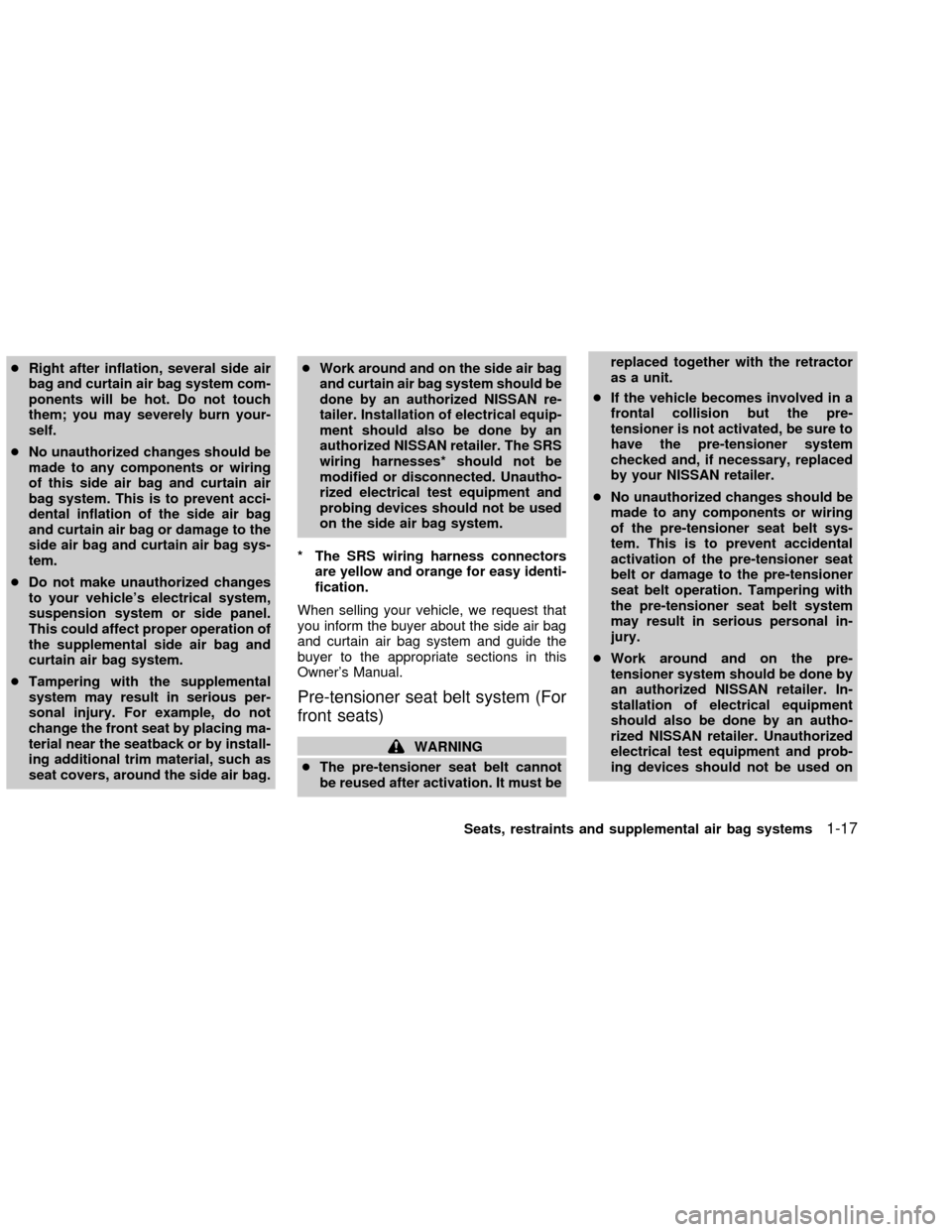
cRight after inflation, several side air
bag and curtain air bag system com-
ponents will be hot. Do not touch
them; you may severely burn your-
self.
cNo unauthorized changes should be
made to any components or wiring
of this side air bag and curtain air
bag system. This is to prevent acci-
dental inflation of the side air bag
and curtain air bag or damage to the
side air bag and curtain air bag sys-
tem.
cDo not make unauthorized changes
to your vehicle's electrical system,
suspension system or side panel.
This could affect proper operation of
the supplemental side air bag and
curtain air bag system.
cTampering with the supplemental
system may result in serious per-
sonal injury. For example, do not
change the front seat by placing ma-
terial near the seatback or by install-
ing additional trim material, such as
seat covers, around the side air bag.cWork around and on the side air bag
and curtain air bag system should be
done by an authorized NISSAN re-
tailer. Installation of electrical equip-
ment should also be done by an
authorized NISSAN retailer. The SRS
wiring harnesses* should not be
modified or disconnected. Unautho-
rized electrical test equipment and
probing devices should not be used
on the side air bag system.
* The SRS wiring harness connectors
are yellow and orange for easy identi-
fication.
When selling your vehicle, we request that
you inform the buyer about the side air bag
and curtain air bag system and guide the
buyer to the appropriate sections in this
Owner's Manual.
Pre-tensioner seat belt system (For
front seats)
WARNING
cThe pre-tensioner seat belt cannot
be reused after activation. It must bereplaced together with the retractor
as a unit.
cIf the vehicle becomes involved in a
frontal collision but the pre-
tensioner is not activated, be sure to
have the pre-tensioner system
checked and, if necessary, replaced
by your NISSAN retailer.
cNo unauthorized changes should be
made to any components or wiring
of the pre-tensioner seat belt sys-
tem. This is to prevent accidental
activation of the pre-tensioner seat
belt or damage to the pre-tensioner
seat belt operation. Tampering with
the pre-tensioner seat belt system
may result in serious personal in-
jury.
cWork around and on the pre-
tensioner system should be done by
an authorized NISSAN retailer. In-
stallation of electrical equipment
should also be done by an autho-
rized NISSAN retailer. Unauthorized
electrical test equipment and prob-
ing devices should not be used on
Seats, restraints and supplemental air bag systems
1-17
ZX
Page 25 of 249
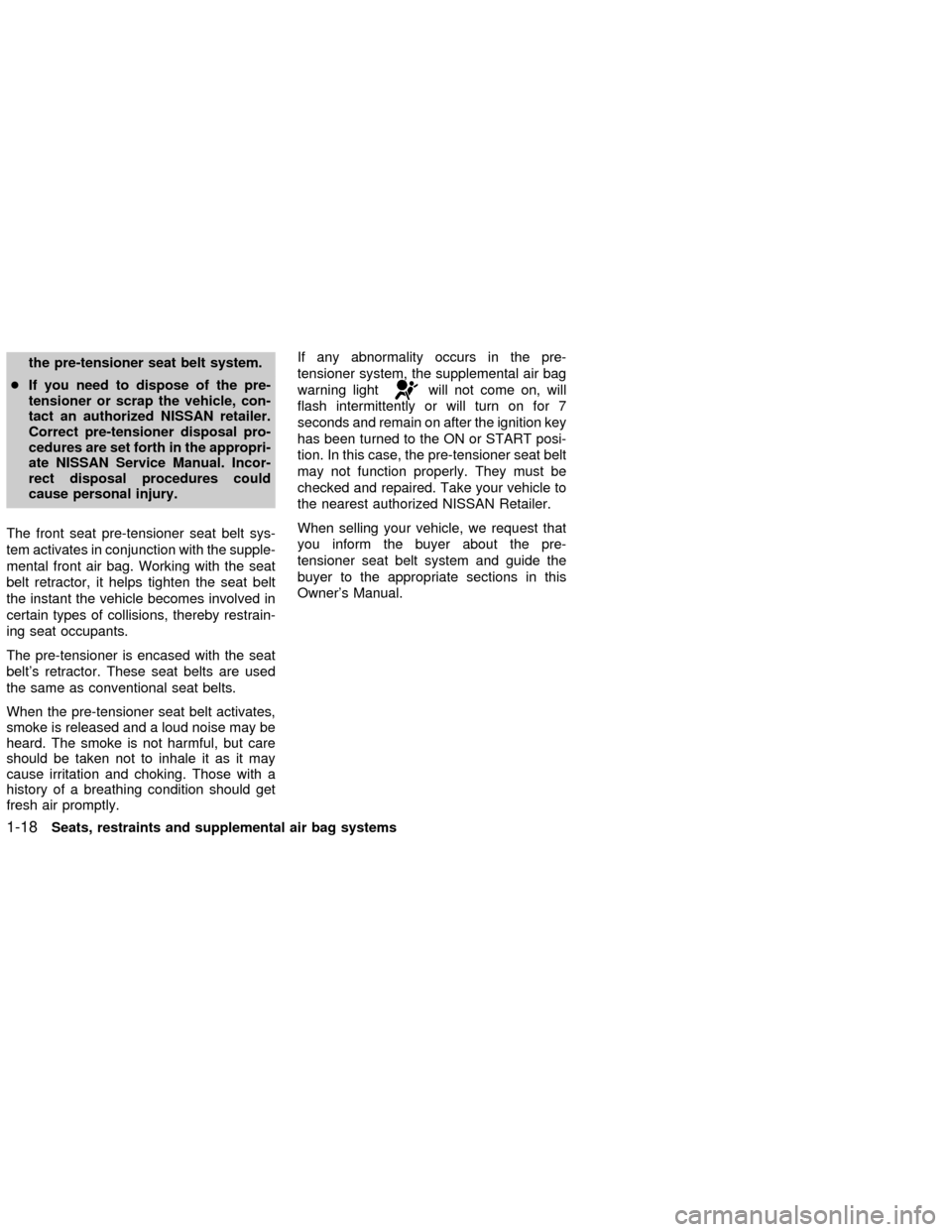
the pre-tensioner seat belt system.
cIf you need to dispose of the pre-
tensioner or scrap the vehicle, con-
tact an authorized NISSAN retailer.
Correct pre-tensioner disposal pro-
cedures are set forth in the appropri-
ate NISSAN Service Manual. Incor-
rect disposal procedures could
cause personal injury.
The front seat pre-tensioner seat belt sys-
tem activates in conjunction with the supple-
mental front air bag. Working with the seat
belt retractor, it helps tighten the seat belt
the instant the vehicle becomes involved in
certain types of collisions, thereby restrain-
ing seat occupants.
The pre-tensioner is encased with the seat
belt's retractor. These seat belts are used
the same as conventional seat belts.
When the pre-tensioner seat belt activates,
smoke is released and a loud noise may be
heard. The smoke is not harmful, but care
should be taken not to inhale it as it may
cause irritation and choking. Those with a
history of a breathing condition should get
fresh air promptly.If any abnormality occurs in the pre-
tensioner system, the supplemental air bag
warning light
will not come on, will
flash intermittently or will turn on for 7
seconds and remain on after the ignition key
has been turned to the ON or START posi-
tion. In this case, the pre-tensioner seat belt
may not function properly. They must be
checked and repaired. Take your vehicle to
the nearest authorized NISSAN Retailer.
When selling your vehicle, we request that
you inform the buyer about the pre-
tensioner seat belt system and guide the
buyer to the appropriate sections in this
Owner's Manual.
1-18Seats, restraints and supplemental air bag systems
ZX
Page 26 of 249

SUPPLEMENTAL AIR BAG
WARNING LABELS
Warning labels about the supplemental
front air bag, supplemental side air bag and
curtain air bag systems are placed in the
vehicle as shown in the illustration.
SUPPLEMENTAL AIR BAG
WARNING LIGHT
The supplemental air bag warning light, dis-
playing
in the instrument panel, moni-
tors the circuits of the supplemental front air
bag, supplemental side air bag and curtain
air bag (if so equipped) and pre-tensioner
seat belt systems. The circuits monitored by
the supplemental air bag warning light are
the diagnosis sensor unit, satellite sensors,
front air bag modules, side air bag modules,
curtain air bag modules, pre-tensioner seat
belts and all related wiring.
WRS0124LRS0100
Seats, restraints and supplemental air bag systems1-19
ZX
Page 27 of 249
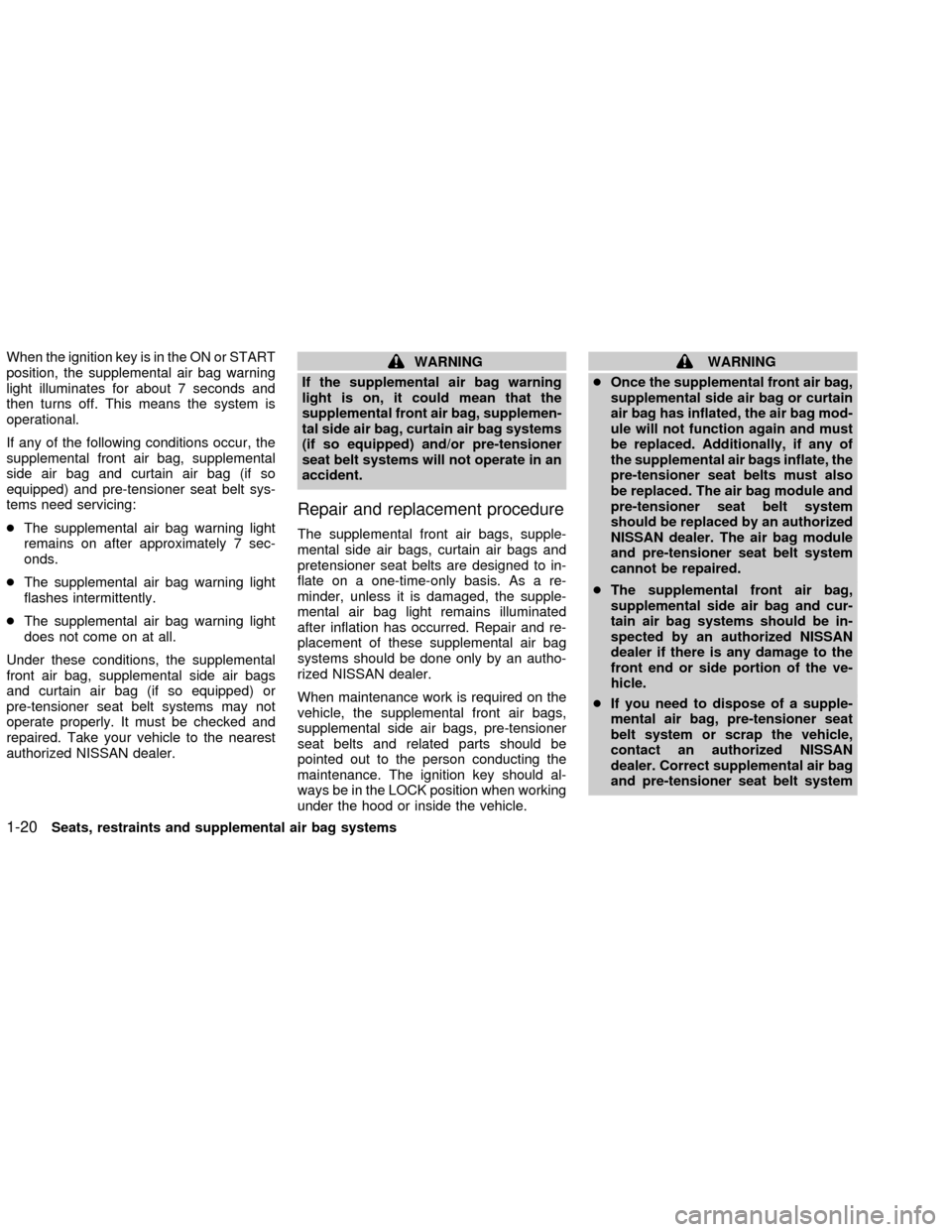
When the ignition key is in the ON or START
position, the supplemental air bag warning
light illuminates for about 7 seconds and
then turns off. This means the system is
operational.
If any of the following conditions occur, the
supplemental front air bag, supplemental
side air bag and curtain air bag (if so
equipped) and pre-tensioner seat belt sys-
tems need servicing:
cThe supplemental air bag warning light
remains on after approximately 7 sec-
onds.
cThe supplemental air bag warning light
flashes intermittently.
cThe supplemental air bag warning light
does not come on at all.
Under these conditions, the supplemental
front air bag, supplemental side air bags
and curtain air bag (if so equipped) or
pre-tensioner seat belt systems may not
operate properly. It must be checked and
repaired. Take your vehicle to the nearest
authorized NISSAN dealer.WARNING
If the supplemental air bag warning
light is on, it could mean that the
supplemental front air bag, supplemen-
tal side air bag, curtain air bag systems
(if so equipped) and/or pre-tensioner
seat belt systems will not operate in an
accident.
Repair and replacement procedure
The supplemental front air bags, supple-
mental side air bags, curtain air bags and
pretensioner seat belts are designed to in-
flate on a one-time-only basis. As a re-
minder, unless it is damaged, the supple-
mental air bag light remains illuminated
after inflation has occurred. Repair and re-
placement of these supplemental air bag
systems should be done only by an autho-
rized NISSAN dealer.
When maintenance work is required on the
vehicle, the supplemental front air bags,
supplemental side air bags, pre-tensioner
seat belts and related parts should be
pointed out to the person conducting the
maintenance. The ignition key should al-
ways be in the LOCK position when working
under the hood or inside the vehicle.
WARNING
cOnce the supplemental front air bag,
supplemental side air bag or curtain
air bag has inflated, the air bag mod-
ule will not function again and must
be replaced. Additionally, if any of
the supplemental air bags inflate, the
pre-tensioner seat belts must also
be replaced. The air bag module and
pre-tensioner seat belt system
should be replaced by an authorized
NISSAN dealer. The air bag module
and pre-tensioner seat belt system
cannot be repaired.
cThe supplemental front air bag,
supplemental side air bag and cur-
tain air bag systems should be in-
spected by an authorized NISSAN
dealer if there is any damage to the
front end or side portion of the ve-
hicle.
cIf you need to dispose of a supple-
mental air bag, pre-tensioner seat
belt system or scrap the vehicle,
contact an authorized NISSAN
dealer. Correct supplemental air bag
and pre-tensioner seat belt system
1-20Seats, restraints and supplemental air bag systems
ZX
Page 28 of 249
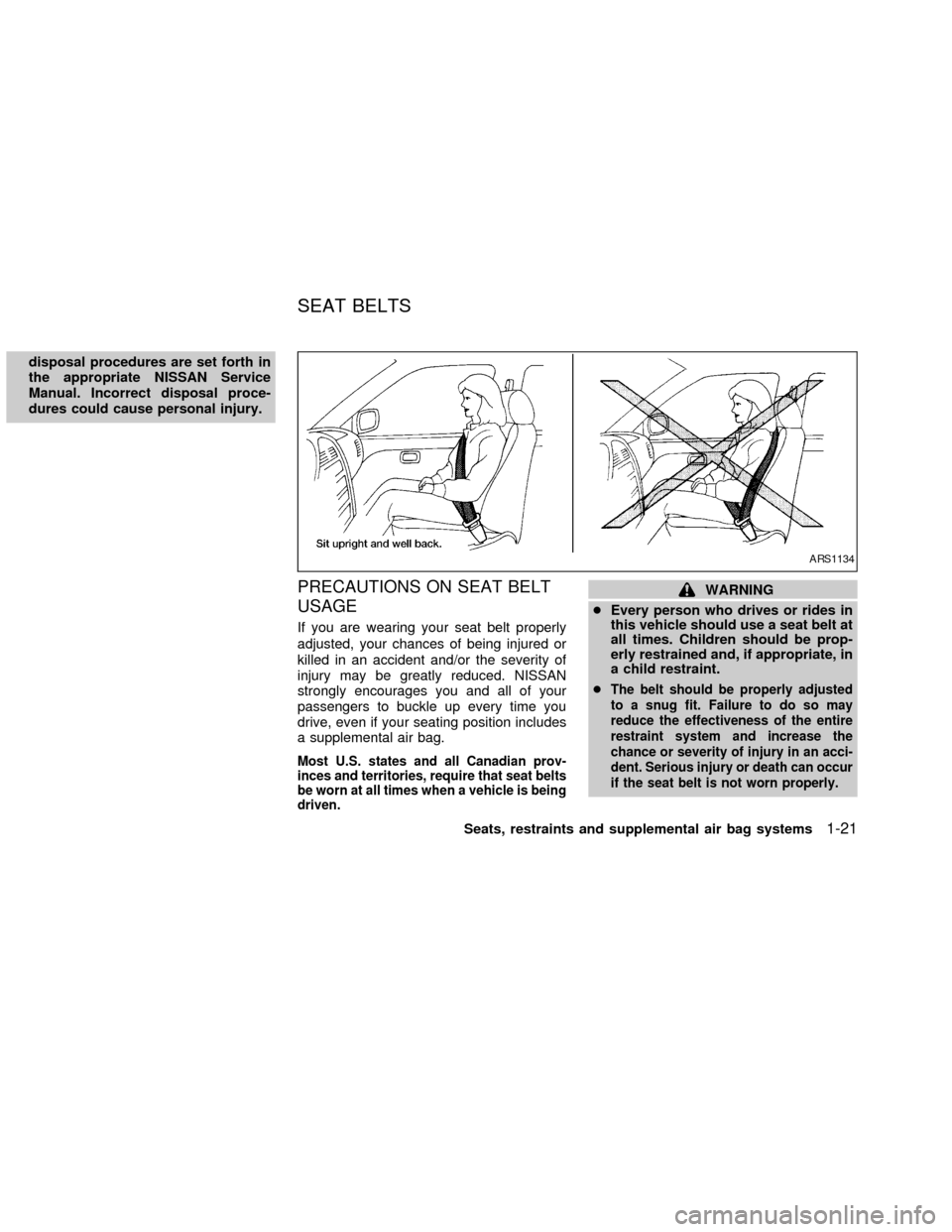
disposal procedures are set forth in
the appropriate NISSAN Service
Manual. Incorrect disposal proce-
dures could cause personal injury.
PRECAUTIONS ON SEAT BELT
USAGE
If you are wearing your seat belt properly
adjusted, your chances of being injured or
killed in an accident and/or the severity of
injury may be greatly reduced. NISSAN
strongly encourages you and all of your
passengers to buckle up every time you
drive, even if your seating position includes
a supplemental air bag.
Most U.S. states and all Canadian prov-
inces and territories, require that seat belts
be worn at all times when a vehicle is being
driven.
WARNING
cEvery person who drives or rides in
this vehicle should use a seat belt at
all times. Children should be prop-
erly restrained and, if appropriate, in
a child restraint.
c
The belt should be properly adjusted
to a snug fit. Failure to do so may
reduce the effectiveness of the entire
restraint system and increase the
chance or severity of injury in an acci-
dent. Serious injury or death can occur
if the seat belt is not worn properly.
ARS1134
SEAT BELTS
Seats, restraints and supplemental air bag systems1-21
ZX
Page 29 of 249
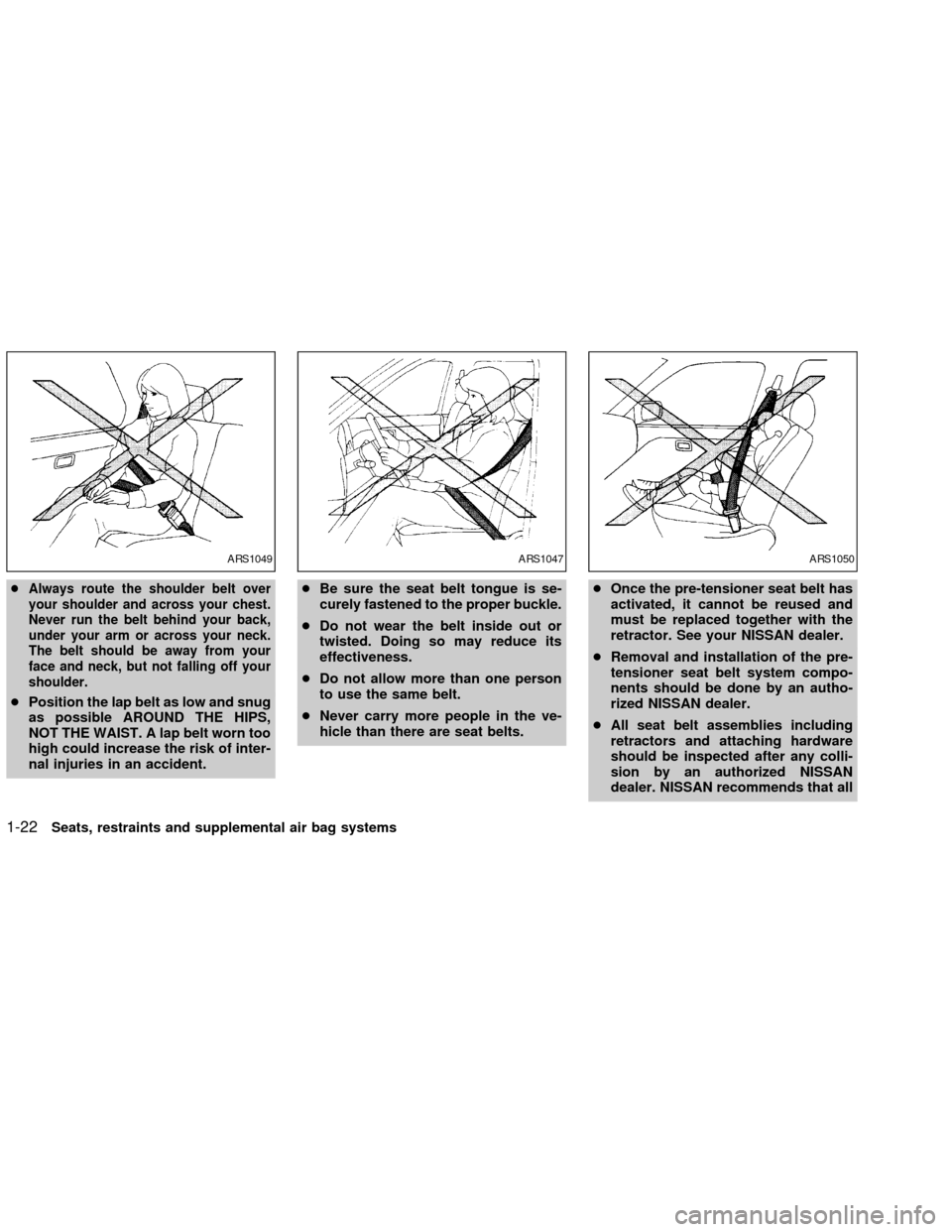
cAlways route the shoulder belt over
your shoulder and across your chest.
Never run the belt behind your back,
under your arm or across your neck.
The belt should be away from your
face and neck, but not falling off your
shoulder.
cPosition the lap belt as low and snug
as possible AROUND THE HIPS,
NOT THE WAIST. A lap belt worn too
high could increase the risk of inter-
nal injuries in an accident.cBe sure the seat belt tongue is se-
curely fastened to the proper buckle.
cDo not wear the belt inside out or
twisted. Doing so may reduce its
effectiveness.
cDo not allow more than one person
to use the same belt.
cNever carry more people in the ve-
hicle than there are seat belts.cOnce the pre-tensioner seat belt has
activated, it cannot be reused and
must be replaced together with the
retractor. See your NISSAN dealer.
cRemoval and installation of the pre-
tensioner seat belt system compo-
nents should be done by an autho-
rized NISSAN dealer.
cAll seat belt assemblies including
retractors and attaching hardware
should be inspected after any colli-
sion by an authorized NISSAN
dealer. NISSAN recommends that all
ARS1049ARS1047ARS1050
1-22Seats, restraints and supplemental air bag systems
ZX
Page 30 of 249
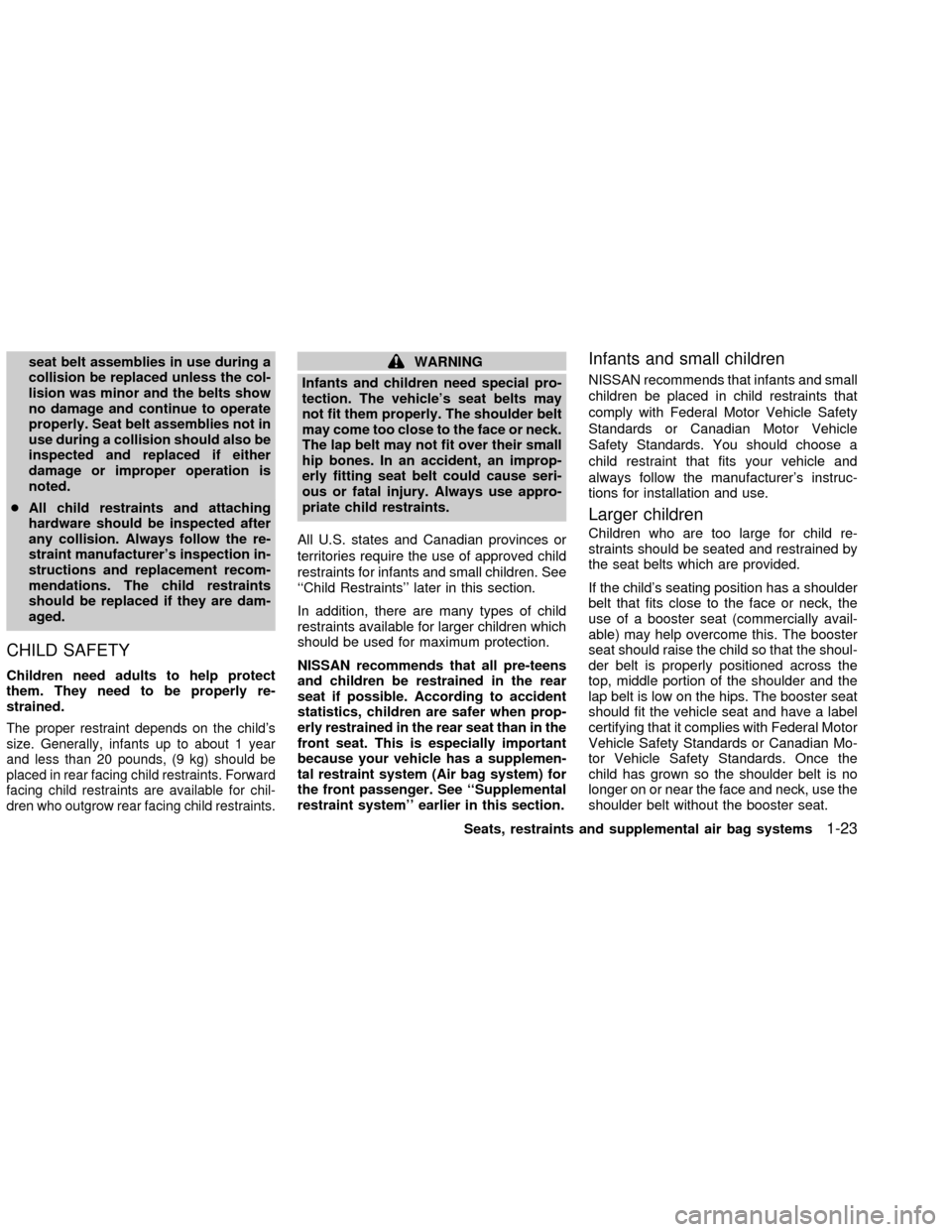
seat belt assemblies in use during a
collision be replaced unless the col-
lision was minor and the belts show
no damage and continue to operate
properly. Seat belt assemblies not in
use during a collision should also be
inspected and replaced if either
damage or improper operation is
noted.
cAll child restraints and attaching
hardware should be inspected after
any collision. Always follow the re-
straint manufacturer's inspection in-
structions and replacement recom-
mendations. The child restraints
should be replaced if they are dam-
aged.
CHILD SAFETY
Children need adults to help protect
them. They need to be properly re-
strained.
The proper restraint depends on the child's
size. Generally, infants up to about 1 year
and less than 20 pounds, (9 kg) should be
placed in rear facing child restraints. Forward
facing child restraints are available for chil-
dren who outgrow rear facing child restraints.
WARNING
Infants and children need special pro-
tection. The vehicle's seat belts may
not fit them properly. The shoulder belt
may come too close to the face or neck.
The lap belt may not fit over their small
hip bones. In an accident, an improp-
erly fitting seat belt could cause seri-
ous or fatal injury. Always use appro-
priate child restraints.
All U.S. states and Canadian provinces or
territories require the use of approved child
restraints for infants and small children. See
``Child Restraints'' later in this section.
In addition, there are many types of child
restraints available for larger children which
should be used for maximum protection.
NISSAN recommends that all pre-teens
and children be restrained in the rear
seat if possible. According to accident
statistics, children are safer when prop-
erly restrained in the rear seat than in the
front seat. This is especially important
because your vehicle has a supplemen-
tal restraint system (Air bag system) for
the front passenger. See ``Supplemental
restraint system'' earlier in this section.Infants and small children
NISSAN recommends that infants and small
children be placed in child restraints that
comply with Federal Motor Vehicle Safety
Standards or Canadian Motor Vehicle
Safety Standards. You should choose a
child restraint that fits your vehicle and
always follow the manufacturer's instruc-
tions for installation and use.
Larger children
Children who are too large for child re-
straints should be seated and restrained by
the seat belts which are provided.
If the child's seating position has a shoulder
belt that fits close to the face or neck, the
use of a booster seat (commercially avail-
able) may help overcome this. The booster
seat should raise the child so that the shoul-
der belt is properly positioned across the
top, middle portion of the shoulder and the
lap belt is low on the hips. The booster seat
should fit the vehicle seat and have a label
certifying that it complies with Federal Motor
Vehicle Safety Standards or Canadian Mo-
tor Vehicle Safety Standards. Once the
child has grown so the shoulder belt is no
longer on or near the face and neck, use the
shoulder belt without the booster seat.
Seats, restraints and supplemental air bag systems
1-23
ZX